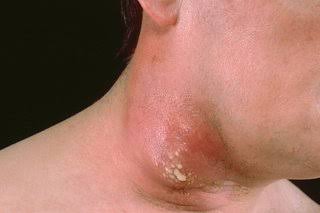Pimples and boils are troublesome problems with the skin that can cause similar symptoms at times.
Pores are small openings in the skin which make it possible for oil to seep out and keep the skin soft. A pimple is a result of a pore becoming clogged.
A boil, or furuncle, is a bacterial infection-induced pus-filled lump. This can appear red and swollen.
Although both boils and pimples can be treated at home by a person, boils can often turn into a serious infection known as a carbuncle.
Find out more in this article about the difference between boils and pimples.
Causes

The effect of excess oil production or an accumulation of dead skin cells and bacteria is often a pimple. During puberty, as the body releases more hormones that can trigger excessive oil production, people may be more likely to develop pimples.
A type of bacteria called Propionibacterium acnes may often infiltrate the skin, causing more redness, discomfort, and irritation.
Most frequently, pimples occur on the face, but they may also appear on the back or neck. They have many types, including blackheads, papules, and whiteheads. Some may be pus-filled, so they may mimic boils very closely.
Staphylococcus aureus bacteria normally live on the surface of the skin, but through a cut, bug bite, or infected hair follicle, they can penetrate the inner layers. This infiltration can result in a boil.
On the sweatiest areas of the skin, boils are most likely to appear. This include the following:
- armpits
- buttocks
- face
- neck
- thighs
Boils begin out as a tiny, round bump, which is usually swollen and red. The bump will fill up with pus over several days. Pressure on the skin increases as the bump develops, eventually causing the boil to rupture and drain.
Diagnosis
With a visual examination, a doctor will also diagnose a boil or a pimple. The doctor will inquire about the signs, the first time the person has experienced the bumps and whether any therapies have been attempted.
The position of the bumps, additional signs and the condition of the underlying skin help a doctor diagnose pimples or boils. Normally, invasive testing is not necessary.
Treatments
Boils and pimples remedies vary. Discover some of the most common techniques below.
Pimples
A comprehensive skincare routine can help to lower the occurrence of pimples for most individuals. It can take 6 to 8 weeks, however for a pimple to heal entirely.
For pimples, a skincare routine should include:
- washing the skin in the morning and evening with warm, not hot, water and a mild cleanser
- using a product containing benzoyl peroxide or salicylic acid, to reduce oil and buildup of dead skin cells in the pores
- applying a gentle moisturizer to reduce any dryness that may have resulted from acne treatment
- exfoliating once or twice a week with a gentle scrub to prevent dead skin cells from collecting
- avoiding squeezing or popping the pimple, as this can invite bacteria into the skin and lead to scarring
If pimples do not go away with home remedies, a person may wish to speak to a dermatologist, a doctor who specializes in managing skin conditions.
Boils

It can help to relieve pain by applying a warm compress to a boil and can encourage the boil to drain. If the boil is in an area that is difficult to reach, a person may instead try resting in a hot bath.
Over-the-counter pain relievers can also alleviate discomfort, such as acetaminophen or ibuprofen.
An antibiotic ointment intended to combat the bacteria within the boil may be administered by a doctor. Or to prevent the infection from spreading to the blood stream, they can prescribe oral antibiotics.
In certain situations, to combat the infection, a doctor will surgically drain the boil and apply topical antibiotics to the area.
A boil should be kept clean and dry with the skin around it. After touching a boil, a person should wash their hands with soap and water, to avoid spreading the infection. The infection may also be spread from individual to individual by exchanging personal care products, such as towels, razors, or makeup brushes.
When to see a doctor
See a doctor if pimples are very painful or do not improve with over-the-counter treatments.
If they have the following symptoms, a person with a boil should seek clinical guidance:
- more than one boil at a time
- a fever
- a boil wider than 2 inches
- a boil that has not disappeared after 2 weeks, despite efforts to treat it at home
- a boil that keeps coming back
- a boil near the eye
Some many boils that appear in the same location can join together, forming a cluster, which is known as a carbuncle. This can lead to illness that causes symptoms that are cold or flu-like.
Boils and pimples are skin disorders that are bothersome but highly treatable.
See a doctor for further care if over-the-counter and home remedies are not adequate.





